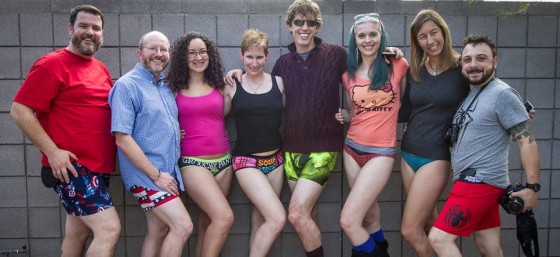
Earlier this month, I had the pleasure of participating in an open photo shoot at a junkyard in Wittmann, Arizona. Dozens of photographers and models converged on this location to shoot around all day in and on the various broken down vehicles and other surroundings. It was a great event to meet other of photographers and models, and to work with the unique aspects of this setting.
As we entered the junkyard, there were 2 large neon green handwritten poster boards that reminded us that we were entering at our own risk, cameras were in use, and that our picture may be taken without our knowledge. Additionally, they said “If you do something stupid we know where to bury you” and “Don’t do anything you don’t want your mom to know about.”
These signs were brilliant and hilarious, but incomplete given that this notice was the closest thing we had to a model release for this event. As a model, I knew what I was getting into; but as a lawyer, it made me cringe.

What is TFP?
This was a TFP photo shoot – Trade For Photos or Time For Pictures depending on your definition. As I understand it, this means it was an open and free event where models and photographers could meet, shoot, and without any money changing hands. After the event, both sides will have had the experience, and the model will get images.
This particular photo shoot was announced as a TFP photo shoot on Facebook without any additional documentation. Without a written contract to the contrary, the photographers are the copyright holder’s to every image they created that day. The models have no copyright rights to the work, not even a license to use the images in their portfolio unless they get that permission from the photographer. Since the models didn’t sign a model release, the photographers can’t sell any of the images they created without risking violating the models’ right to publicity.
Writing a Simple Model Release
An effective model release does not have to be long, complicated, or filled with legalese. It can be a simple contract that everyone has to sign prior to entering the shoot that lays out the ground rules for the event. The model release should clearly state what rights the models give the photographers and with the photographers give the models in return – such as a license to use any image from the shoot in their portfolio or online with an attribution.
The release for this particular event probably should have included a liability waiver given that we were climbing in and on broken down vehicles and surrounded by broken glass and gagged metal. We all should have been required to sign off that we were responsible for our own actions and wouldn’t go after the owners of the junkyard or anybody present in the event that we fell or got tetanus.
I wrote a simple one-page model release for a swimming pool photo shoot last summer that every model and photographer had to sign with their contact information. This put everybody on the same page from the beginning of the event, including the acknowledgment of the “No Jerks” rule, and since everyone provided their contact information, it was easy for models and photographer to connect after the event.
The next time I see an invitation for an open TFP photo shoot, perhaps I should offer to write a simple release for the event, especially if I’m going to be a model there. If you have a question about copyright, model releases, or photography rights, please contact me directly or connect with me on Twitter, Facebook, YouTube, or LinkedIn.
Lights Camera Lawsuit
There’s always a need for quality legal information for photographers. That’s why I created an online course called Lights Camera Lawsuit: The Legal Side of Professional Photography to address photographers’ most important questions. I want you to feel secure in your business, confident in the way you operate day-to-day, knowing that you’ve set yourself up to get paid what your worth without incident.
At $497, the course contains nearly six hours of legal information you can immediately apply to your business. That’s less than what I charge for two hours of legal work for clients!
Please subscribe for more information and to make sure you don’t miss out on any special offers or discounts.








